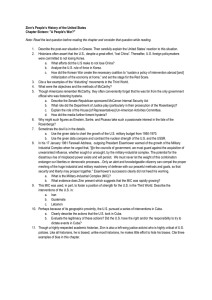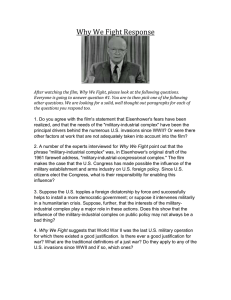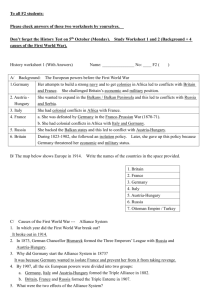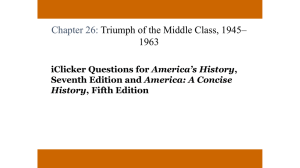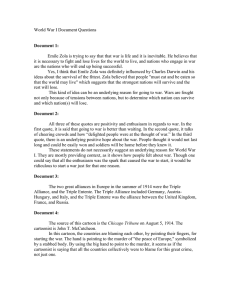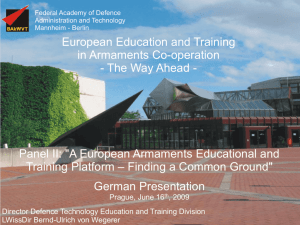Conference notes
advertisement
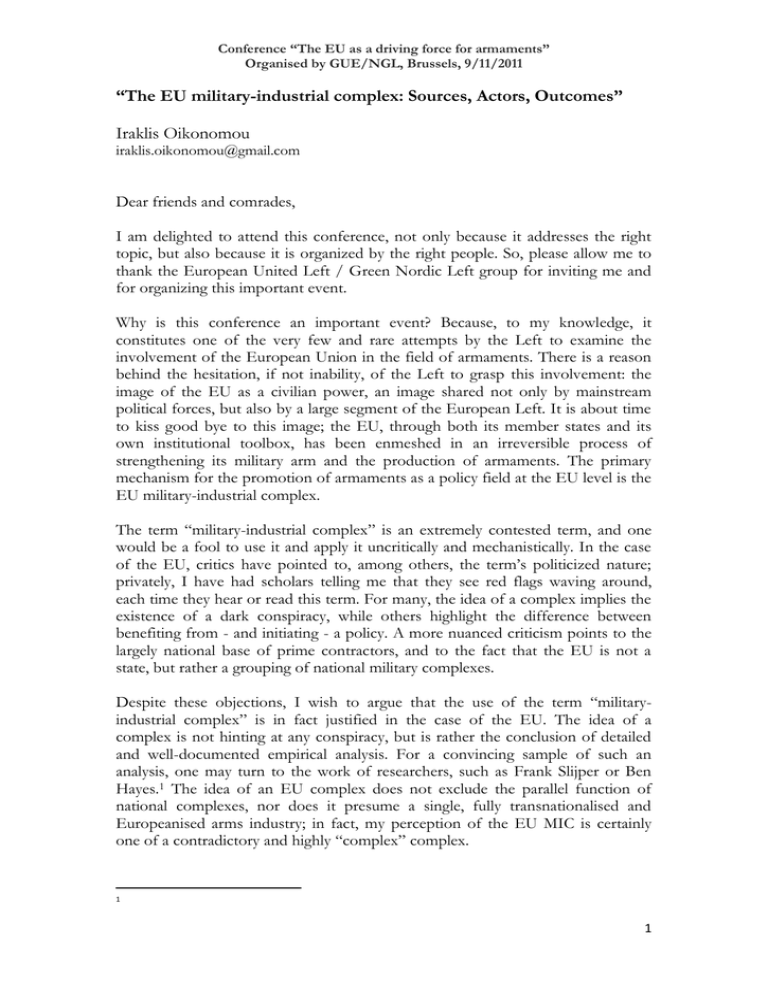
Conference “The EU as a driving force for armaments” Organised by GUE/NGL, Brussels, 9/11/2011 “The EU military-industrial complex: Sources, Actors, Outcomes” Iraklis Oikonomou iraklis.oikonomou@gmail.com Dear friends and comrades, I am delighted to attend this conference, not only because it addresses the right topic, but also because it is organized by the right people. So, please allow me to thank the European United Left / Green Nordic Left group for inviting me and for organizing this important event. Why is this conference an important event? Because, to my knowledge, it constitutes one of the very few and rare attempts by the Left to examine the involvement of the European Union in the field of armaments. There is a reason behind the hesitation, if not inability, of the Left to grasp this involvement: the image of the EU as a civilian power, an image shared not only by mainstream political forces, but also by a large segment of the European Left. It is about time to kiss good bye to this image; the EU, through both its member states and its own institutional toolbox, has been enmeshed in an irreversible process of strengthening its military arm and the production of armaments. The primary mechanism for the promotion of armaments as a policy field at the EU level is the EU military-industrial complex. The term “military-industrial complex” is an extremely contested term, and one would be a fool to use it and apply it uncritically and mechanistically. In the case of the EU, critics have pointed to, among others, the term’s politicized nature; privately, I have had scholars telling me that they see red flags waving around, each time they hear or read this term. For many, the idea of a complex implies the existence of a dark conspiracy, while others highlight the difference between benefiting from - and initiating - a policy. A more nuanced criticism points to the largely national base of prime contractors, and to the fact that the EU is not a state, but rather a grouping of national military complexes. Despite these objections, I wish to argue that the use of the term “militaryindustrial complex” is in fact justified in the case of the EU. The idea of a complex is not hinting at any conspiracy, but is rather the conclusion of detailed and well-documented empirical analysis. For a convincing sample of such an analysis, one may turn to the work of researchers, such as Frank Slijper or Ben Hayes.1 The idea of an EU complex does not exclude the parallel function of national complexes, nor does it presume a single, fully transnationalised and Europeanised arms industry; in fact, my perception of the EU MIC is certainly one of a contradictory and highly “complex” complex. 1 1 Conference “The EU as a driving force for armaments” Organised by GUE/NGL, Brussels, 9/11/2011 But how can the EU MIC be defined? Here is my own definition: The EU militaryindustrial complex is a relatively cohesive, yet contradictory, bloc of socio-economic, politicoinstitutional, military and ideological forces operating at the EU level, aiming at the promotion of the interests of internationalised European military-industrial capital and the strengthening of the Union's power projection capacity through armaments policy integration. In the case of the EU MIC, one finds the three essential elements of any MIC: sources, actors, and outcomes. In terms of sources, there are two key distinct but interrelated processes: the internationalization of the European arms industry, and the establishment of the European Security and Defence Policy. The first one, primarily economic in nature, culminated in the late 1990s with the formation of truly multinational European arms manufacturers, such as EADS. Its roots are to be found in the privatization wave of the 1980s, and in the subsequent national and international concentration and centralization of capital. The need for industrial consolidation was primarily driven by falling military budgets after the Cold War, competition from outside the EU, and the rising costs of R&D for armaments. Eventually, ever larger companies with ever larger market shares began forming a dense web of international linkages and interconnections through mergers, acquisitions and other forms of industrial collaboration. This was the process that produced a powerful socio-economic subject whose interests required a management of its affairs at the EU level. Yet, this subject also required a veil of legitimacy for its actions; a veil that was soon to be found in the European Security and Defence Policy, initiated in the late-1990s through the Anglo-French consensus at St. Malo. Subsequent developments, such as the completion of multiple military missions and the drafting of the European Security Strategy, covered the actions of the industry and its allies with an aura of emergency and technocratic necessity. The emphasis of ESDP on power projection opened up endless opportunities for legitimizing the production of more and better weapons, as well as the homogenization of national requirements and markets. Add to this the quest for European autonomy vis-à-vis the US, plus the notion of the unity of external and internal security, and you get a very broad range of arguments in favour of the armaments agenda, which helped legitimize some politically ambiguous measures and decisions. Let’s move from sources to actors. As you may have already guessed, I regard the European, internationalised military-industrial capital as the primary agency in the EU MIC. Why? Because the military-industrial capital lies closest to the production of armaments; and, given its position within the social production of the means of violence, it is a class subject whose economic power is systematically translated into political power. Indeed, economic consolidation fuelled a process of political consolidation of the European arms industry, which led to the settingup of the AeroSpace and Defence Industries Association of Europe (ASD) in 2004. The decision of the three sectoral lobbying groups (European Defence Industries Group - EDIG, European Association of Aerospace Manufacturers AECMA, and Association of European Space Industry - EUROSPACE) to merge 2 Conference “The EU as a driving force for armaments” Organised by GUE/NGL, Brussels, 9/11/2011 into one integrated scheme would have never been realized without the prior wave of international and inter-sectoral mergers and acquisitions. The depth and density of the involvement of the industry in co-authoring EU armaments policy and in setting its agenda cannot be seen as simply an act of lobbying. Philosopher Istvan Mészáros has noted that ‘the expression “militaryindustrial complex”…clearly indicates that what we are concerned with is something much more firmly grounded and tenacious than some direct political/military determinations (and manipulations) which could be in principle reversed at that level’. What we are dealing with here is a much more in-depth, structural involvement, regularized, normalized and prioritized by a set of EU institutions. The European Commission and its DG Enterprise and Industry stand out as the politico-institutional nucleus of the complex; they form its state-like command centre in the absence of an EU state, producing the ‘general interest’ as a long-term vision. Such an interest needs to receive an intergovernmental confirmation via the Council of the European Union, as well as via the European Defence Agency, an intergovernmental agency formally in charge of EU armaments affairs. Its role in capabilities development is increasingly coupled by its role in funding research and technology projects, enhancing armaments cooperation and delineating strategies for maintaining a strong European Defence Technological and Industrial Base - an euphemism for military-industrial corporate profitability. The European Parliament with its unquestionable, bipartisan support for the EU MIC’s cause provides a flair of popular support, strengthened by key individuals in the Security and Defence Subcommittee. However, there can be no military-industrial complex without the military. Through their participation in ESDP-related military committees, such as EUMC, the military has been deciding upon requirements and addressing capability gaps to be filled by the manufacturers. Finally, the EU Institute for Security Studies has been producing state-of-the-art analyses of ESDP and its estimated requirements, as well as forecasts for industrial profitability. A final set of actors comprises elements of a “civil society”, such as private think tanks (Security & Defence Agenda) and informal political groupings (The Kangaroo Group). To a great extent, “civil society” consists of initiatives funded by the industry itself. On another note, organised labour has been a faithful supporter of the armaments agenda, via the positions taken by the European Metalworkers’ Federation. The mobilization of labour aristocracy highlights the magnitude of the complex and the hegemony enjoyed by arms manufacturers, in class terms. Needless to say that next to the “civil society” stands the state, in the form of the national military-industrial complexes of arms-producing states. These operate parallel to the EU MIC; the latter complements the former, rather than substituting them. In terms of outcomes, the EU MIC can first and foremost boast of introducing new lines of funding, such as the Commission-inspired European Security Research Program and its precursor, the Preparatory Action for Security Research. The European Defence Agency is also a source of funding for military R&D, 3 Conference “The EU as a driving force for armaments” Organised by GUE/NGL, Brussels, 9/11/2011 while the European Commission has been feeding the development of major space programs with military applications, such as Galileo and GMES. In fact, there is a trend of transferring civil funding into military funding, as shown by the case of Galileo and the collapse of the public-private partnership. In the absence of a pan-European procurement agency - apart from the European Space Agency and its procurement of satellites - most of the funding concerns research and technology, rather than procurement of equipment. However, the outcome cannot be grasped purely in quantitative, funding terms. There is a qualitative dimension of outcomes that facilitate military-industrial interests, even if they do not always have a direct financial impact. One such outcome is the reform of the European market landscape for armaments through the Commission’s Defence Package. Another qualitative aspect is the formal participation of the industry in EU policy-making through novel channels; take the case of ASD Committees in the context of the EDA, or the numerous “experts’ reports” (STAR21, Group of Personalities, LeaderSHIP 2015) drafted under the close supervision of industrialists and the aegis of the Commission. Note also the impact EU projects have on industrial consolidation. By actively promoting collaborative projects, EU also promotes further mergers and acquisitions, contributing to stronger and larger arms manufacturers. That said, one should be cautious to not over-emphasize the effectiveness and linearity of the complex. The lack of an EU state and of a single, transnational military-industrial subject means that national divergences are persisting. The lack of financial resources in times of crisis is also all-encompassing. The EU militaryindustrial complex is real, involving institutions of different intergovernmental and supranational forms; yet, it is extremely contradictory as well, especially when compared to the function of national MICs, such as the US one. On the one hand, European capitalism is systematically reproducing militarization; on the other hand, financial constraints and multiple national state/capital preferences limit the impact and effectiveness of the complex. Essentially, we are faced with a divergence between the global scope of capital and the limited scope of the nation-state; it is, as Ellen Wood frames it, a problem of the ‘non-correspondence between capitalism’s economic and political forms’. While economic-industrial developments necessitate supranational, state-like institutional arrangements, the nation-state remains indispensable for the reproduction of the national militaryindustrial complexes, and the political preconditions of capitalist hegemony. Any decent political analysis must come with a proposal, so they say. Here is one: there is an urgent need for the establishment of a Brussels-based research hub, addressing issues relating to the security and military dimensions of the EU. So, I submit the idea of establishing a center for the study of EU security and armaments policy and of processes of militarization in Europe. Such a center would collect vital data and documentation, encourage critical research, stimulate public debates and inform alternative policy proposals both inside and outside the European Parliament; in other words, it would strengthen resistance to militarization. The story of the EU MIC highlights the importance of ideas. Ideas 4 Conference “The EU as a driving force for armaments” Organised by GUE/NGL, Brussels, 9/11/2011 matter, and the arms industry and its allies has understood this very well; take the numerous experts’ organizations, conferences, publications and research programs funded by arms manufacturers. Counter-hegemonic forces need to follow this ‘example’. Do not ask me who would be willing to support and fund such an initiative, how and why; as the French philosopher Jean-Paul Sartre once said, “when people ask you for directions, you simply tell them where the street is; you do not take the strangers outside the home they are going to”. To end, let me add one more quotation, by MEP Sabine Lösing: ‘What we need is not more military, what we need is a change, an end to the European Union’s neoliberal orientation”. The external orientation of the EU towards power projection and militarization, and the internal orientation towards neoliberalism and social exploitation are two interconnected processes, and the battle against the one needs to incorporate the battle against the other. 5
